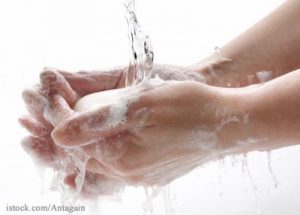FoodSafety.gov is offering advice about hand washing, now that the holidays are over and cold and flu season is here. Proper hand washing is the most effective way to reduce infection and illness, especially foodborne illness.
 People often touch their ears, eyes, and noses without even realizing they are doing it. Your hands should be washed before eating food, before, during, and after preparing food, before and after treating a cut or wound, and before and after caring for someone who is sick. Always wash your hands with soap and water after handling uncooked eggs or raw meat, poultry, and seafood.
People often touch their ears, eyes, and noses without even realizing they are doing it. Your hands should be washed before eating food, before, during, and after preparing food, before and after treating a cut or wound, and before and after caring for someone who is sick. Always wash your hands with soap and water after handling uncooked eggs or raw meat, poultry, and seafood.
The correct way to wash your hands is to use warm water, lots of soap, and lather for 20 seconds. Be sure to scrub the backs of your hands, between the fingers, and under the fingernails. Studies show that hand washing can reduce respiratory illnesses in the general population by about 20%.
It’s also important that you practice cleanliness in the kitchen. All surfaces and utensils should be washed after each use, using soap and water or washing them in the dishwasher. Use paper towels or clean cloths to wipe up spills on kitchen surfaces, and wash those cloths often in the dishwasher using hot water. Cutting boards and countertops should be washed with hot soapy water before and after food preparation.
Finally, remember to wash fruits and vegetables before eating them or preparing them. Bacteria can linger in the crevices of fruit and vegetable surfaces. Scrub firm product with a clean brush, and always rinse produce under running water. Then dry produce with a paper towel or clean kitchen towel. Launder your kitchen towels frequently and consider using bleach to sanitize them in the wash.
But, don’t rinse meat, poultry, or eggs. The only way to kill bacteria found on those foods is to heat them to at least 160°F. Rinsing these foods, especially poultry, can cause bacteria to aerosolize and spread around the kitchen. Studies have shown that rinsing chicken spreads bacteria, including Campylobacter and Salmonella, up to three feet away from the kitchen faucet, where it settles on surfaces.





Very good article…and I agree with all the recommendations with the exception of the cooking temperature. Poultry must be cooked to a minimum of 165 degrees.
You know, I have struggled with this number when writing recipes for cookbooks. You are right, 165°F is the temperature for safe chicken, but if you are testing chicken right out of the oven, some sources say 160°F is fine, since the temperature will continue to rise for about 5 minutes, reaching the safe temperature of 165°F. Some sources also say that whole chickens and turkeys should be cooked to 180°F!